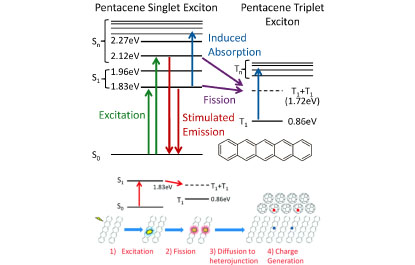Dr Akshay Rao (Optoelectronics)
Molecular semiconductors based on π-conjugated organic molecules posses a wide range of tuneable optical and electronic properties. These properties have been employed in organic light emitting diodes (OLEDs), which are seeing wide scale commercial application and in the emerging area of organic photovoltaics (OPVs). But one of the overlooked properties in these systems is that of spin. We have recently demonstrated electron spin can be used to block recombination of electron-hole pairs in organic photovoltaics, thus allowing for greater current out of the devices [1]. We have also demonstrated that a carrier multiplication process in organics, that of exciton fission, can occur on ultrafast timescales with very high efficiency [2]. This is made possible by the spin conserving nature of the process. Harnessing exciton fission could allow for the extraction of two electrons from high-energy photons absorbed in solar cells, removing a fundamental barrier to high efficiency photovoltaics.
This project aims to provide a deeper insight into both the above-described processes. We aim to use novel ultrafast optical pump-probe and pump-push-probe experiments, conducted in the presence of applied magnetic fields to unravel the complex interaction between the spin and electronic degrees of freedom in these systems. Understanding these interactions will allows us to engineer optimised systems, which can fully harness them and boost device performance.
[1] Rao et al, Nature, 2013, 500, 435–439.
[2] Rao et al, JACS, 2010, 132 (36), pp 12698–12703.

The mechanism of ultrafast fission in pentacene and how it can be used to generate multiple electron-hole pairs per photon absorbed.
Project Completed July 2015
This grant led to the development of several new experimental techniques, led to new collaborations both within and outside Cambridge, resulted in several high impact papers, a patent and industrial collaboration, and greatly contributed to the raising of further funding from EPSRC and InnovateUK. Most crucially, it has led to several key breakthroughs, which have changed our understanding of key photo-physical phenomena in organic semiconductors and at interfaces between organic and inorganic semiconductors.
Key publications
1) Gelinas et al., Science 2014.
2) Tabachnyk et al., Nature Materials, 2014.
3) Musser et al., Nature Physics, 2015.
Further funding
1) Innovate UK Energy Catalyst £300,000
2) EPSRC Super Solar Challenge (with Prof Greenham) £1,020,028
3) EPSRC Early Career Fellowship £1,336,321

